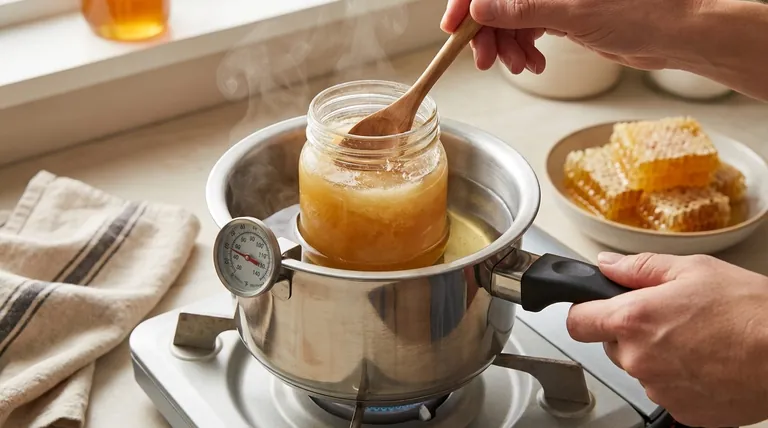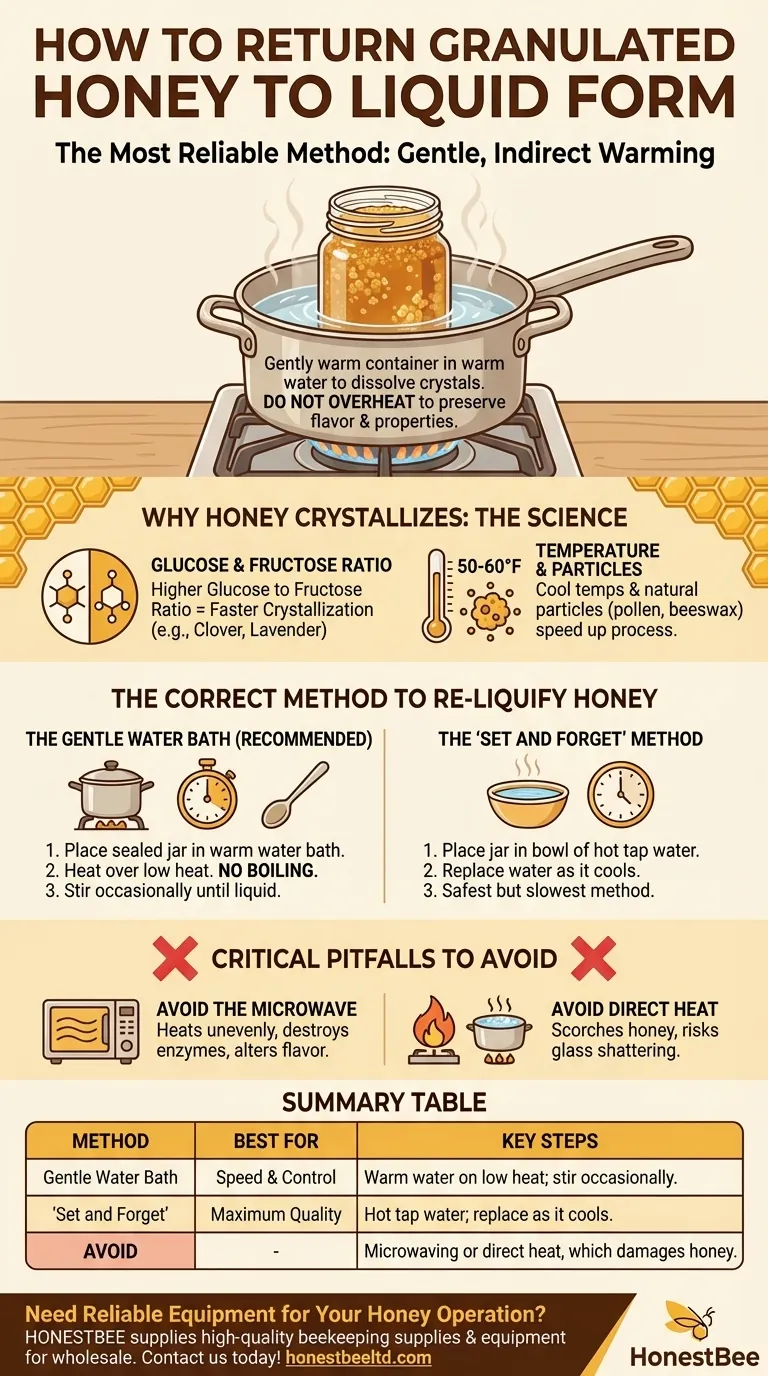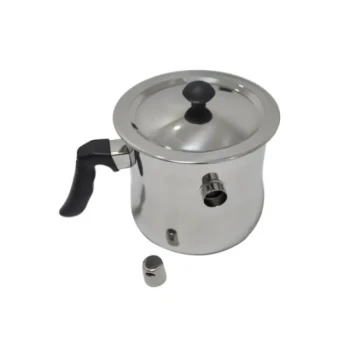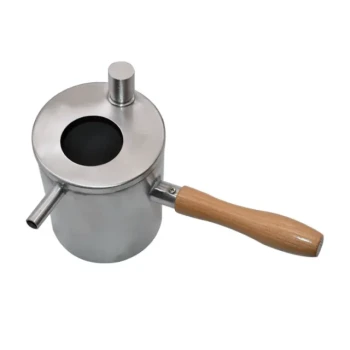The most reliable way to return granulated honey to its liquid form is to gently and indirectly warm it. Place the honey container in a pot or bowl of warm water, allowing the crystals to slowly dissolve back into the solution. This gentle process ensures you do not overheat the honey, which would damage its delicate flavor and beneficial properties.
Honey granulation is not a sign of spoilage or poor quality; it is a natural process that proves the honey is pure. The key to restoring its liquid texture is applying gentle, indirect heat, which protects the very characteristics that make raw honey valuable.

Why Honey Crystallizes: The Science of Granulation
Understanding why honey crystallizes in the first place is key to managing it. Honey is a supersaturated solution, meaning it contains more sugar than can naturally remain dissolved. This makes crystallization inevitable over time.
The Glucose and Fructose Ratio
Honey is primarily composed of two sugars: glucose and fructose. Glucose is significantly less soluble in water than fructose, causing it to crystallize more easily.
Honeys with a higher ratio of glucose to fructose, such as clover or lavender honey, will crystallize much faster than those with lower ratios, like acacia or tupelo honey.
The Role of Temperature
Temperature plays a critical role in the speed of granulation. Cool temperatures, particularly between 50-60°F (10-15°C), are the ideal range for crystals to form rapidly.
This is why storing honey in a cold pantry or the refrigerator will accelerate the crystallization process, contrary to what many people assume.
The Presence of Natural Particles
Small particles of pollen, beeswax, and propolis suspended in raw, unfiltered honey act as nucleation points. These particles provide a starting surface on which the glucose crystals can begin to form, speeding up the process.
The Correct Method to Re-liquify Honey
The goal is always to warm the honey, never to cook it. Gentle, controlled heating is the only way to preserve its natural enzymes, flavor, and color.
The Gentle Water Bath (Recommended)
This method offers the best balance of speed and control.
- Place your sealed jar of honey into an empty pot or saucepan.
- Fill the pot with warm water until it reaches about halfway up the side of the jar.
- Heat the pot on the stove over low heat. Do not let the water boil.
- As the honey warms, stir it occasionally to break up the crystals and distribute the heat evenly.
- Once the honey has returned to its liquid state, remove it from the water bath.
The "Set and Forget" Method
This is the safest, albeit slowest, method. Simply place your honey jar in a bowl of hot tap water and let it sit. The process may take longer and require you to replace the water as it cools, but it virtually eliminates any risk of overheating.
Critical Pitfalls to Avoid
How you re-liquify honey is as important as the act itself. Aggressive heating will permanently alter the honey.
Avoid the Microwave
Microwaving is not recommended. It heats unevenly and far too quickly, creating super-hot spots that will caramelize the sugars and destroy the delicate enzymes and aromatic compounds. This fundamentally changes the honey's flavor and nutritional profile.
Avoid Direct Heat
Never place a honey jar directly on a stove burner or in a pot of boiling water. This intense, direct heat will scorch the honey at the bottom of the jar and can cause glass containers to shatter due to thermal shock.
Making the Right Choice for Your Honey
Your approach depends on your priority, whether it's speed or the absolute preservation of quality.
- If your primary focus is speed: Use the gentle stovetop water bath, monitoring it closely to ensure the water never gets hotter than a comfortable hand-washing temperature.
- If your primary focus is preserving maximum quality: Use the slower method of placing the jar in a bowl of hot tap water, replacing the water as needed until the honey is clear.
- If your primary focus is prevention: Store your honey at a stable room temperature in a dry, dark place like a pantry, and never in the refrigerator.
By applying gentle heat, you can easily manage crystallization and enjoy your pure honey in its liquid form whenever you choose.
Summary Table:
| Method | Best For | Key Steps |
|---|---|---|
| Gentle Water Bath | Speed & Control | Place jar in warm water on low heat; stir occasionally. |
| 'Set and Forget' | Maximum Quality | Place jar in hot tap water; replace water as it cools. |
| Avoid | - | Microwaving or direct heat, which damages honey. |
Need reliable equipment for your honey operation? HONESTBEE supplies high-quality, durable beekeeping supplies and equipment to commercial apiaries and distributors through our wholesale-focused operations. From honey warming cabinets to extraction tools, we provide the solutions you need to maintain product quality and scale your business efficiently. Contact HONESTBEE today to discuss your wholesale needs!
Visual Guide

Related Products
- Beeswax Melter for Candle Making Honey Bee Wax Melter
- Electric Honey Press Machine for Squeezing Honey Comb Press Equipment
- 10L Stainless Steel Electric Honey Press Machine
- Steam Beeswax Melter Wax Warmer for Wax Processing
- HONESTBEE 72 Frame Industrial Electric Honey Extractor for Beekeeping
People Also Ask
- How does a steam wax melter work? A Fast, Efficient Method for High-Quality Wax
- How do water jacket melters function? Achieve Gentle, Scorch-Free Melting for Sensitive Materials
- What are the benefits of using a professional wax melter? Achieve Consistent, Scalable, and Safe Production
- What is the flashpoint of beeswax? Essential Safety and Quality Tips for Beekeepers
- What is the best way to melt beeswax for candles? The Safest Method for Professional Results



















